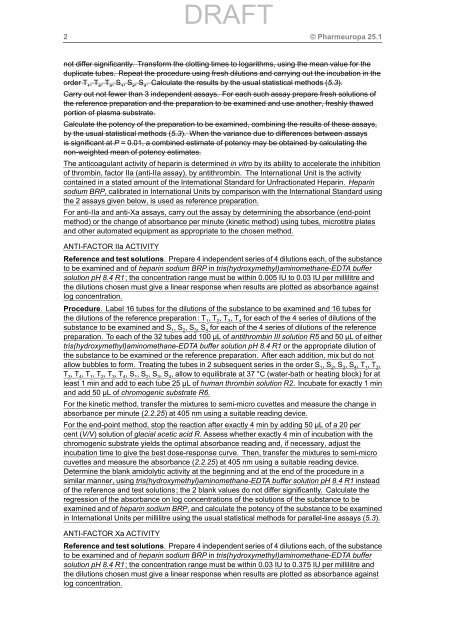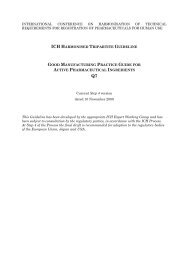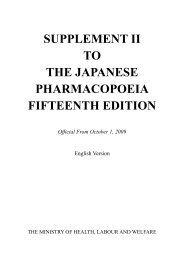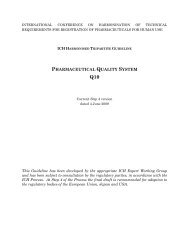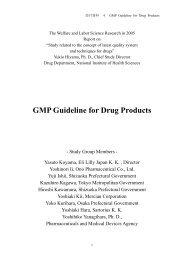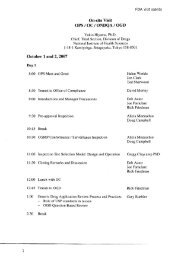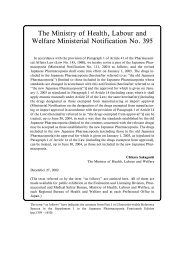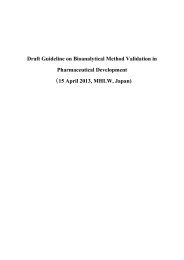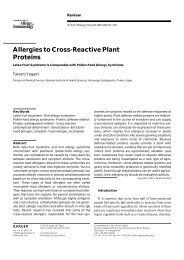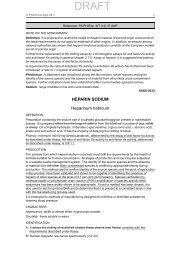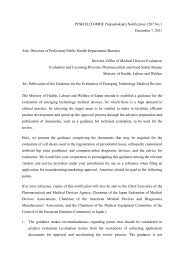2.7.5. ASSAY OF HEPARIN - NIHS
2.7.5. ASSAY OF HEPARIN - NIHS
2.7.5. ASSAY OF HEPARIN - NIHS
You also want an ePaper? Increase the reach of your titles
YUMPU automatically turns print PDFs into web optimized ePapers that Google loves.
DRAFT<br />
2 © Pharmeuropa 25.1<br />
not differ significantly. Transform the clotting times to logarithms, using the mean value for the<br />
duplicate tubes. Repeat the procedure using fresh dilutions and carrying out the incubation in the<br />
order T 1<br />
, T 2<br />
, T 3<br />
, S 1<br />
, S 2<br />
, S 3<br />
. Calculate the results by the usual statistical methods (5.3).<br />
Carry out not fewer than 3 independent assays. For each such assay prepare fresh solutions of<br />
the reference preparation and the preparation to be examined and use another, freshly thawed<br />
portion of plasma substrate.<br />
Calculate the potency of the preparation to be examined, combining the results of these assays,<br />
by the usual statistical methods (5.3). When the variance due to differences between assays<br />
is significant at P = 0.01, a combined estimate of potency may be obtained by calculating the<br />
non-weighted mean of potency estimates.<br />
The anticoagulant activity of heparin is determined in vitro by its ability to accelerate the inhibition<br />
of thrombin, factor IIa (anti-IIa assay), by antithrombin. The International Unit is the activity<br />
contained in a stated amount of the International Standard for Unfractionated Heparin. Heparin<br />
sodium BRP, calibrated in International Units by comparison with the International Standard using<br />
the 2 assays given below, is used as reference preparation.<br />
For anti-IIa and anti-Xa assays, carry out the assay by determining the absorbance (end-point<br />
method) or the change of absorbance per minute (kinetic method) using tubes, microtitre plates<br />
and other automated equipment as appropriate to the chosen method.<br />
ANTI-FACTOR IIa ACTIVITY<br />
Reference and test solutions. Prepare 4 independent series of 4 dilutions each, of the substance<br />
to be examined and of heparin sodium BRP in tris(hydroxymethyl)aminomethane-EDTA buffer<br />
solution pH 8.4 R1; the concentration range must be within 0.005 IU to 0.03 IU per millilitre and<br />
the dilutions chosen must give a linear response when results are plotted as absorbance against<br />
log concentration.<br />
Procedure. Label 16 tubes for the dilutions of the substance to be examined and 16 tubes for<br />
the dilutions of the reference preparation: T 1<br />
, T 2<br />
, T 3<br />
, T 4<br />
for each of the 4 series of dilutions of the<br />
substance to be examined and S 1<br />
, S 2<br />
, S 3<br />
, S 4<br />
for each of the 4 series of dilutions of the reference<br />
preparation. To each of the 32 tubes add 100 µL of antithrombin III solution R5 and 50 µL of either<br />
tris(hydroxymethyl)aminomethane-EDTA buffer solution pH 8.4 R1 or the appropriate dilution of<br />
the substance to be examined or the reference preparation. After each addition, mix but do not<br />
allow bubbles to form. Treating the tubes in 2 subsequent series in the order S 1<br />
, S 2<br />
, S 3<br />
, S 4<br />
, T 1<br />
, T 2<br />
,<br />
T 3<br />
, T 4<br />
, T 1<br />
, T 2<br />
, T 3<br />
, T 4<br />
, S 1<br />
, S 2<br />
, S 3<br />
, S 4<br />
, allow to equilibrate at 37 °C (water-bath or heating block) for at<br />
least 1 min and add to each tube 25 µL of human thrombin solution R2. Incubate for exactly 1 min<br />
and add 50 µL of chromogenic substrate R6.<br />
For the kinetic method, transfer the mixtures to semi-micro cuvettes and measure the change in<br />
absorbance per minute (2.2.25) at 405 nm using a suitable reading device.<br />
For the end-point method, stop the reaction after exactly 4 min by adding 50 µL of a 20 per<br />
cent (V/V) solution of glacial acetic acid R. Assess whether exactly 4 min of incubation with the<br />
chromogenic substrate yields the optimal absorbance reading and, if necessary, adjust the<br />
incubation time to give the best dose-response curve. Then, transfer the mixtures to semi-micro<br />
cuvettes and measure the absorbance (2.2.25) at 405 nm using a suitable reading device.<br />
Determine the blank amidolytic activity at the beginning and at the end of the procedure in a<br />
similar manner, using tris(hydroxymethyl)aminomethane-EDTA buffer solution pH 8.4 R1 instead<br />
of the reference and test solutions; the 2 blank values do not differ significantly. Calculate the<br />
regression of the absorbance on log concentrations of the solutions of the substance to be<br />
examined and of heparin sodium BRP, and calculate the potency of the substance to be examined<br />
in International Units per millilitre using the usual statistical methods for parallel-line assays (5.3).<br />
ANTI-FACTOR Xa ACTIVITY<br />
Reference and test solutions. Prepare 4 independent series of 4 dilutions each, of the substance<br />
to be examined and of heparin sodium BRP in tris(hydroxymethyl)aminomethane-EDTA buffer<br />
solution pH 8.4 R1; the concentration range must be within 0.03 IU to 0.375 IU per millilitre and<br />
the dilutions chosen must give a linear response when results are plotted as absorbance against<br />
log concentration.


